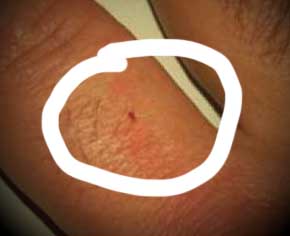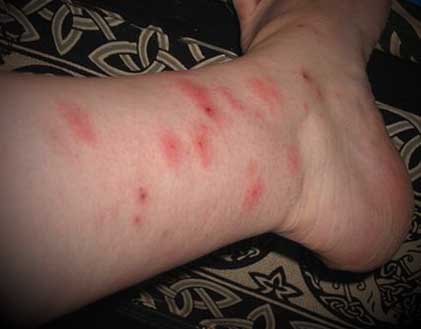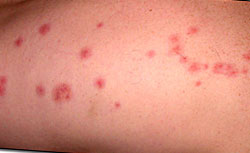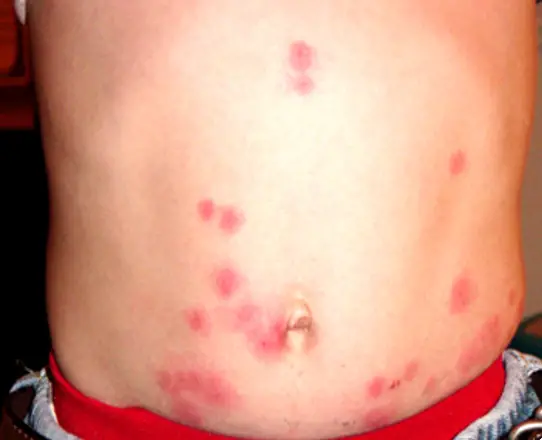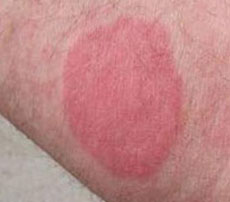Bedbug Bites: Everything You Need to Know
If the bed bug bites aren’t healing, or you see signs of puss or infection, be sure to see a Doctor.
Pictures of Bed Bug Bites
This page may contain affiliate links to products we recommend, researched and love. If you decide to make a purchase after clicking one of these links, I’ll earn some coffee money which we promise to drink while writing more helpful content like this. We do not recommend any product we wouldn’t use ourselves.
Overview
Each of the following pictures of bed bug bites shows typical skin reactions to the insect’s saliva. Most people are not hypersensitive to the bites and will show no reaction at all with the exception of two small dots where the bedbug punctured the skin. Other people can develop more severe symptoms such as red papular eruptions (raised inflamed areas) or in severe cases, blisters.
Most bites will have a small clear area in the center surrounded by redness that may or may not be raised. People tend to become more sensitive and have larger reactions after each episode. Reactions can include itch, swelling, rash, and wheals (large round red area on the skin). Severe reactions can cause skin blisters and trouble breathing, although these reactions are very rare.
Skin reactions can occur immediately, hours, days or even up to two weeks later. Itch, the primary symptom beyond a red raised area, should subside in 1 to 3 days. Bed bug bites should go away with no treatment in 4 to 7 days.
Because individual allergic skin reactions can vary as shown in the following bed bug bite images, and people can become more or less sensitive to bed bug bites over time, bites alone cannot confirm the presence of bed bugs. Also look for other factors such as actual insects or blood and fecal stains on a mattress. Research shows that 11 out of 24 people have no reaction when first bitten. However, when bitten again most developed a skin reaction. (1)
What makes healthcare so expensive in America? Rather than mere overuse of medical services, a study published in the Journal of the American Medical Association found that the high cost of medical treatments and procedures is what makes healthcare expenditures twice as costly in the U.S. than in other wealthy countries, The Washington Post
Picture of Bed Bug Feeding on Skin. Adult Bed Bugs are About the Size of an Apple Seed
If you skin symptoms match any of the pictures of bed bug bites, look for other signs of an infestation.
Bed Bug Feeding On Hand
Pictures of Bed Bug Bites on Humans
When people ask “show me pictures of bed bug bites” they are often thinking that all bites look the same. The reality is that reactions are different in each person.
Bed bugs bites will appear on areas of the body that are exposed during sleep. The most common areas are the legs, arms, shoulders, and neck. The bite itself will feel like a tickle or pinch. Patterns are often in a straight line.
Said another way, if you see bites only under areas that are covered in clothes, and you see no other signs of an infestation such as live insects or mattress stains, in all likelihood the skin reaction you are seeing IS NOT caused by bed bugs.
Do not scratch the bites as it can cause a skin infection. Bite reactions can occur immediately or in a few days.
Typical Allergic Skin Reactions
Bed Bug Bite Skin Reaction After 30 Minutes on Lower Leg
Bed Bug Bites on Leg
Bed Bug Bite Patterns
It is common to see bed bug bites in a row of 3 or 4 bites or a cluster. This could be due to an arm or leg resting on an infested mattress seam.
Bed Bug Bite Pattern on Arm
Bed bug bites can appear individually, in groups or in rows.
What do Bed Bug Bites Look Like on Arms?
Bed bug bites most commonly are found on exposed skin areas during sleep such as the lower legs, shoulders, and arms.
Cluster of Bed Bug Bites on Arm
Bed Bug Bites In a Row. Could be caused by leg leading against mattress seam where bedbugs are hiding.
Bed Bug Bites on Stomach. Bites are typically 2mm to 5mm. Bites are referred to as erythematous ( redness of the skin or mucous membranes due to the accumulation of blood in dilated capillaries) or maculopapular (flat, reddened area of skin present in a rash) lesions.
Back of 4 Year Old Bitten by Hundreds of Bed Bugs. Quantity of Bites Make Skin Look Like a Rash Instead of Bites
Bed Bug Bite Wheal Skin Reaction
The Bed Bug bite wheal pattern see below is usually seen in people that that have had other bed bug bite episodes and are now more sensitive to the bites.
Bed Bug Skin Wheal Reaction
Author: R. Naylor
The size of the skin reaction depends on the allergic response of the individual. Hypersensitive individuals will have larger reactions.
Bed Bug Wheal Skin Reaction
Bed Bug Bite on Leg – Wheal Reaction
Blister Reaction
In advanced cases bed bug skin reactions can turn into blisters.
Picture of Bed Bug Skin Blisters
Author: Leverkus
Bed Bug Bite Blisters Hypersensitive Reaction
Stages of Bed Bug Bites
Bed bug bite images vary based on the individual and how allergic they are.
Bed Bug Bites 4 Days After Being Bitten
Bed Bug Bite 1 Week After Being Bitten on Skin
Diagnosis
- Chicken Pox
- Staphylococcus infection
- Spider or Mosquito Bites
- Hives
- Allergies to food
- Reaction to medications such as antibiotics
- Scabies
Bed Bug Bites Treatment
Treatment for bedbugs bites involves addressing itchy bites, soothing the skin, and then preventing any infection. After Bite makes an anti-itch anti-microbial gel formula that is specifically formulated to provide relief bed bug itching and to promote healing.
In most cases, medical attention will not be needed if you have been bitten. For severe reactions or if you have difficulty breathing, immediately seek emergency medical care.
If the bed bug bites aren’t healing, or you see signs of puss or infection, be sure to see a Doctor.
Tell-Tale Signs of Bed Bugs
Do not rely only on bite symptoms when determining if you have a bed bug infestation. Bed bug bites look like bites from other common insects. Skin reactions can be caused by insect stings from fire ant stings, insect bites from spiders, mosquito bites, and scabies to name a few. Other causes include skin irritation from exposure to household chemicals or some type of allergy.
- Pattern: Middle of the bite is clear with a red ring around the middle.
- Symptoms: Most bites are very itchy
- Location: Bed bugs do not bite through clothing and only bite exposed skin. This includes the arms, legs, shoulders, and neck. Bites are rarely seen on the bottoms of the feet. If this is the location of the bite, see a doctor and ask if the condition is scabies.
- Presence of Actual Bed Bugs: You can see baby bed bugs and adult bed bugs with the naked eye. Use a credit card or thin brush to work through the mattress seam to see if you dislodge any insects. It might be helpful to have a flashlight and magnifying glass. You can also spot small overall off-white bed bug eggs attached to rough surfaces. Note that bed bugs can change in appearance as they absorb human blood.
- Signs on the Mattress: Small brown spots on a mattress (bed bug feces) or small blood spots could indicate the presence of bed bugs. Of course, spotting the bugs themselves is a sign. They hide in the seams of the mattress. Even one bed bug can cause a problem. Other areas where bed bugs are commonly found include around the headboard, night tables, and crevices between the walls and floor.
Picture of Bed Bug Stains on Mattress
Why You Need a Bed Bug Professional
Do not only rely on pictures of bedbug bites to confirm that bed bugs are your problem. For example, bites that occur only on the bottoms of the legs are more likely to be flea bites.
Call in a professional that knows how to spot an infestation that might be in the walls of your home or hidden in a bed frame.
We recommended using the exterminators registered with Home Advisor. You can also call eLocal at 1.877.673.2704 for a pest control expert near you. Members of these networks are licensed and reviewed. There is no charge to receive a quote. You can also look at our directory of bed bug pest control experts.
Protect Yourself From Bed Bugs
Until you treat your home, minimize bare skin to cut off the bed bugs’ food source. At night wear socks over the bottom of pajamas and mittens over shirt sleeves. Keep your bed away from other furniture and blankets off the floor.
Brochures
Each of these free brochures is filled with pictures of bed bug bite examples such as photos of rashes, skin reactions, mattress signs, and information.
Bedbug Bites: Everything You Need to Know
Bedbugs are tiny insects that feed on blood from humans or animals. Over-the-counter treatments can help relieve itching and inflammation.
Bedbugs are flat, oval-shaped, and reddish-brown in color. They can live in your bed, furniture, carpet, clothing, and other belongings, and are most active at night.
Bedbugs don’t have wings, so they rely on animals or humans to carry them from one place to another. They typically get into your home after an overnight trip — by hitching a ride in your luggage or clothing. Or they can enter your home if you bring in secondhand furniture that’s infested. They can also travel from one apartment to the next if a building or hotel has an infestation.
Although bedbug bites are rarely dangerous, they can be very itchy. In some cases, they become infected or cause an allergic reaction.
Keep reading to learn about bedbug bites, what they look like, and how to treat and prevent them.
Bedbugs excrete a tiny amount of anesthetic before feeding on people, so you won’t feel it when they bite you. It can sometimes take a few days for symptoms of bedbug bites to develop.
Some people never develop noticeable symptoms from bedbug bites. According to Pest Control Technology, approximately 30 to 60 percent of people never develop a reaction to a bedbug bite. When symptoms do develop, the bites tend to be:
- red and swollen, with a dark spot at the center of each bite (they may also look like a hive or welt)
- arranged in lines or clusters, with multiple bites grouped together
- itchy
- burning
- fluid-filled blisters
- you may also find blood stains on the sheets from scratching
Scratching bug bites can cause them to bleed or become infected.
Where on the body do bedbug bites occur?
Bedbugs can bite any part of your body. However, they’ll normally bite areas of skin that are exposed while you sleep. This includes your face, neck, arms, and hands. If you typically wear pajamas to bed, the bug will bite along the line of the clothing.
Do bedbugs bite every night?
Bedbugs don’t always feed every single night. In fact, they can go several weeks without eating. That might sound like a good thing, but it can make it more difficult to notice that there are bedbugs in your home. In fact, it may take a few weeks to realize that the bites are part of a larger pattern. And that’s problematic because bedbugs can multiply very quickly. A female can lay eggs every 3 to 4 days.
In most cases, bedbug bites get better within 1 to 2 weeks. To relieve symptoms, you can:
- Apply an over-the-counter or prescription steroid cream to decrease inflammation and itching.
- Take an oral antihistamine to reduce itching and burning.
- Use an over-the-counter pain reliever to relieve swelling and pain.
- Take a Benadryl prior to sleep to decrease itching or have a doctor prescribe a stronger antihistamine.
In addition to over-the-counter medications, there are several home remedies that may help relieve the symptoms of bedbug bites. Try applying one or more of the following:
- a cold cloth or an ice pack wrapped in a towel
- a thin paste of baking soda and water
Allergic reactions and infections from bedbug bites
Although rare, there have been isolated case reports of systemic allergic reactions to bedbug bites. Reactions typically included hives, asthma, and in rare occasions, anaphylaxis.
In addition, constant scratching of lesions caused by bedbug bites may lead to secondary infections, such as impetigo, folliculitis, or cellulitis. To reduce the risk of infection, wash the bites with soap and water, and try not to scratch them.
If you suspect that you’ve developed an infection or allergic reaction to a bedbug bite, contact your doctor. Get emergency medical care if you develop any of the following after being bitten:
- multiple hives
- difficulty breathing
- wheezing
- swelling of the throat or mouth
- fever
- chills
- dizziness
- confusion
If you suspect that your baby or child has been bitten by bedbugs, check their sheets, mattress, bed frame, and nearby baseboards for signs of the bugs.
Washing the bites with soap and water will help treat bedbug bites on your baby or child. For additional relief, consider applying a cold compress or over-the-counter anti-itch creams or low-strength steroids. Make sure to cut the baby’s nails short so they can’t scratch their skin.
Talk with your child’s doctor or pharmacist before using topical steroid creams or oral antihistamines to treat the bites. Some medications may not be safe for babies or young children.
If your child is old enough to understand your instructions, ask them not to scratch the bites. To prevent scratching, it may also help to trim your child’s nails and cover the bites with a bandage.
If you suspect there are bedbugs in your home, look for signs of them in your bed and other areas. They usually hide during the day in:
- household cracks or crevices
- walls
- luggage
- bedclothes
- mattresses
- bedsprings
- bed frames
- spaces under baseboards
- loose or peeling wallpaper
- electrical switch plates
- conduits for electrical cables
- sofas (if a person is using the sofa to sleep on)
Bedbugs typically live near where people are sleeping in the house. That’s because bedbugs are attracted to body heat and carbon dioxide. They don’t usually travel to other rooms if people aren’t sleeping there. Bedbugs typically feed from midnight until dawn and then hide during the day in the same place they were prior to biting.
You may not see the bugs themselves, but you may find drops of blood or small black dots of bug droppings in your bed. If you find bedbugs, call your landlord or a pest control company.
It’s very difficult to find bedbugs unless you’re professionally trained to do so. Most pest control companies will do a check free of charge. If they find bedbugs, they’ll typically give you several options to eliminate them.
Remember, until you’ve eliminated the infestation, do not visit or sleep at someone else’s house or a hotel as this may potentially spread the bugs to their home or hotel room.
Risk factors for getting bedbugs
Bedbugs can live in any home or public area. But they’re common in places that have a lot of people, a lot of turnover, and close quarters. That’s why you may be at increased risk for encountering bedbugs if you live or work in a:
- hotel
- hospital
- homeless shelter
- military barrack
- college dorm
- apartment complex
- business office
Bringing secondhand furniture into your home is another risk factor as is having visits from friends or relatives who may have bedbugs in their home.
To contain and eliminate a bedbug infestation, it helps to:
- Vacuum and steam-clean your floors, mattresses, furniture, and appliances.
- Launder your linens, drapes, and clothing using the hottest settings of your washing machine and dryer.
- Seal items that can’t be laundered in plastic bags and store them for several days at 0°F (-17°C) or for several months at warmer temperatures.
- Heat items that can be safely heated to 115°F (46°C).
- Fill gaps around your baseboards and cracks in furniture with caulking.
It’s almost impossible to get rid of bedbugs without an exterminator. Many exterminators today use nonchemical eradication, such as very high heat or very cold liquid nitrogen. These options may be the most effective way to eliminate bedbugs as bedbugs are resistant to most pesticides.
Find more tips for managing bedbug infestations and learn when to call a professional.
Bedbugs travel from place to place by hiding in items, such as furniture, clothing, blankets, and luggage. Bedbugs can live for months without feeding. This makes it easy to accidentally bring bedbugs into your home without knowing.
There are steps you can take to help prevent bedbugs:
- Travelers who are exposed to bedbugs or are concerned about bedbugs should decontaminate luggage, clothes, and belongings upon returning home, using mechanical methods (brushing, vacuuming, heating, washing, or freezing).
- Always use luggage racks when you travel to keep your clothes off the floor and away from hotel furniture.
- Keep your suitcase away from your bed when you return home from a trip, and run your clothes through a dryer cycle before putting them away.
- Store your clothing in vacuum-sealed bags when you travel.
- When you return home from traveling, seal items that can’t be washed in a plastic bag for several weeks.
- If you’re a frequent traveler, you can get a device that heats your suitcase to a temperature that will kill any bedbugs.
- Inspect any secondhand furniture, linen, or clothing for signs of bedbugs before bringing it into your home.
- If you use a shared laundry room, transport your laundry in plastic bags and don’t fold it until you return home.
Bedbug bites and fleabites are quite similar in appearance, although flea bites are typically a bit smaller. Both can cause red bumps to form on your skin. Both can be very itchy.
When fleas bite you, they typically bite the lower half of your body, or warm, moist areas around joints. For example, they may bite:
- your feet
- your ankles or legs
- your armpits
- the inside of your elbows or knees
Bedbugs are more likely to bite upper parts of your body, such as:
- your hands
- your arms
- your neck
- your face
Bedbug bites also occur at night and look like hives. But later in the day they get smaller and look more like a pimple.
If you suspect that bedbugs or fleas have bitten you, check for signs of the bugs in your home. Bedbugs often hide in the seams of mattresses, cracks of bed frames and headboards, and baseboards around beds. Fleas tend to live on family pets and in carpets or upholstered furniture.
You can also visit a dermatologist who can examine the bites and help determine what the cause may be.
If you find bedbugs or fleas, it’s important to treat your home or pet to get rid of them.
Share on Pinterest Flea bites tend to occur on the feet, ankles, or lower leg. Source: Getty Images (Dermnet, Wikimedia, etc.)


